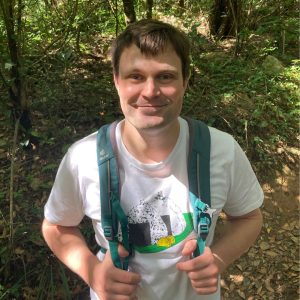Best poster prize winners at ‘Cellular mechanisms driven by phase separation’
Last month, we had the pleasure of welcoming onsite and virtual participants to the EMBO | EMBL Symposium ‘Cellular mechanisms driven by phase separation.’ The event brought together scientists from cell biology, biophysics, biochemistry, molecular biology, structural biology, developmental biology, polymer physics, and soft matter physics to study condensates in biology and disease.
The Advanced Training Centre (ATC) was filled with vibrant discussions, lots of networking, and mesmerising science. An absolute highlight of the event is the poster sessions, where the participants go around the ATC’s helixes to discover the newest research on the topic and then get to vote for the best posters. So today, we are thrilled to present you the winners of the best posters of the event. 🌟 Read on!
Protection of DNA from mechanical stresses at the nuclear envelope
Presenter: Ramesh Adakkattil, Max Planck Institute of Molecular Cell Biology and Genetics, Germany

Eukaryotic cells encapsulate DNA molecules within a protein-membrane scaffold called the nuclear envelope, in part to protect the genome from mechanical stresses caused by internal and external forces as a consequence of cell migration, cell division or tissue compression. While it is known that an improperly assembled nuclear envelope is associated with DNA damage, cancer and envelopathies, it remains unclear how the nuclear envelope organizes DNA to provide mechanical resistance in the first place. Here, we show how protein components of the nuclear envelope organize DNA and increase its mechanical stability to withstand forces that would otherwise damage double-stranded DNA. We use a bottom-up reconstitution approach coupled with optical tweezer experiments, theoretical physics and cell biology to investigate how the chromatin cross-bridging factor BAF, the inner nuclear membrane protein LEM2 and DNA self-organize. Our data point to a mechanism where BAF-LEM2 organizes DNA into regular loops and further jointly compact into large fluid-like DNA-protein co-condensates. As a result, DNA is mechanically protected in several ways: Firstly, forces with the potential to damage DNA percolate along the co condensates through several different molecular interactions, reducing the mechanical stress on individual DNA strands. Secondly, the array of protein complexes along DNA function like an ensemble of springs that actively stiffen DNA and elevates its melting and breaking points. The higher the tension on DNA, the stronger BAF and LEM2 pull DNA back. Our in-cell AFM experiments combined with theory indicate that BAF-LEM2 modules exert high pulling forces on the chromatin surface that build the effective surface tension of the organelle. As an extension in cells, we observe that cells suffer severe nuclear morphology defects and DNA damage when LEM2 is depleted. Our study quantitatively describes a conserved and previously unknown molecular mechanism by which cells use the nuclear envelope as a self-assembling buffer against spontaneously occurring mechanical stress to protect DNA from damage, suggesting a first preventive mechanism that adds to the cell’s ability to repair DNA damage or responsively change chromatin properties.
Due to the confidentiality of the unpublished data, we cannot share the poster.
The cytoskeleton positions protein condensates
Presenter: Thomas Böddeker, Humboldt-Universität zu Berlin, Germany

Many protein condensates inside human cells are liquid-like droplets composed of protein and mRNA.These condensates interact with the heterogeneous, active and dense environment of the cytoplasm, crossed by various cytoskeletal filaments such as microtubules and filamentous actin. Strikingly, many protein condensates assume stereotypical positions within the cytoplasm that may have physiological relevance, e.g. for efficient signaling. We find that the cytoskeleton is of critical importance for the positioning of stress granules, a cytosolic protein condensate, within the cell. In particular, we identify complementary functions of filamentous actin and microtubules in the positioning of stress granules. Stress granules couple to actin’s native dynamics in the cell through steric interactions leading to directional motion towards the cell center. Microtubules (and their molecular building-blocks), on the other hand, act as Pickering agents and engage in energetically favorable wetting interactions that lead to a robust localization of stress granules in microtubule-rich regions of the cell. Microtubules, in turn, deform in response to capillary forces, resulting in network modulations around stress granules. These mutual interactions are non-specific as they ultimately arise from different material properties (surface tension, contact angles, rigidity) of the condensate and contacting substrate. The underlying physical interactions do not require specific interactions, such as protein binding, suggesting that such capillary phenomena may impact localization and/or motion of many condensates and that capillary force generation may be a distinct function of protein condensates.
Can biomolecular condensates create oxygen partitioning?
Presenter: Ankush Garg, Aarhus University, Denmark

Condensates can create a special internal milieu to regulate biochemical reactions through partitioning of biomolecules. Here, we explore how oxygen partitioning is affected by condensates. We propose two hypotheses to what might determine oxygen partitioning. Firstly, molecular oxygen is hydrophobic and is expected to get concentrated into the more hydrophobic interior of condensates. Secondly, the high density of polymers in the condensate excludes oxygen from part of the volume of the condensate and thus decreasing oxygen concentrations inside. Here, we investigate which of these effects dominate. We investigate oxygen partitioning into condensates formed by synthetic repeat of intrinsically disordered proteins. Oxygen concentrations are measured using phosphorescence lifetime imaging microscopy (PLIM) using metal-organic sensors and electrochemical probes. We observe less oxygen concentration in the droplet compared to that of bulk which signifies the importance of free accessible volume concept. We hope to understand the basis behind oxygen partitioning which will help us create anaerobic reaction crucibles that might be useful in production of complex natural compounds in microbial cell factories.
PRC1 composition and chromatin interaction define condensate stability, dynamics, and morphology
Presenter: Stefan Niekamp, Massachusetts General Hospital and Harvard Medical School, USA

Maintaining precise gene expression levels is essential for defining cellular identity and for preventing various diseases, including developmental disorders and cancers. The Polycomb repressive complex 1 (PRC1) plays a key role in gene repression. Canonical PRC1 has been shown to form condensates in vitro and in cells and the ability of PRC1 to undergo liquid-liquid phase separation has been proposed to contribute to maintenance of repression. However, how chromatin and the various subunits of PRC1 contribute to condensation is poorly understood. To address this, we developed a TIRF microscopy-based approach using reconstituted protein complexes enabling real-time observation of condensate formation at the single molecule level. Our findings reveal that nucleosomal arrays lower the critical concentration required for PRC1 condensate formation from the micromolar to nanomolar regime, indicating a synergistic effect between chromatin and PRC1. Furthermore, we identified that a sufficient length of chromatin and a stoichiometric excess of PRC1 to nucleosomes are essential for condensation. Using single-molecule and live cell imaging, we found that the exact combination of PHC and CBX subunits of PRC1 determine the initiation, morphology, stability, and dynamics of condensates. In particular, the polymerization activity of PHC2 significantly influences condensate dynamics, promoting the formation of structures with distinct domains that adhere to each other without coalescing. Taken together, our data suggest that PRC1 binding to chromatin establishes an initial scaffold crucial for efficient condensate formation. This dual-component scaffolding mechanism may ensure that condensates only form at specific loci where PRC1 molecules can bind nucleosomes and create an initial scaffold. Additionally, our results suggest that the composition of PRC1 can tune the material properties of condensates, providing flexibility in regulatory function across various developmental stages.
Unravelling the role of oxidative stress and RNA binding in TDP-43 aggregation: implications for neurodegenerative diseases
Presenter: Aleksandra Sergeeva, Max Planck Institute of Molecular Cell Biology and Genetics, Germany
The cytoplasmic aggregation of the nuclear TAR DNA binding protein-43 (TDP-43) is a pathological hallmark of amyotrophic lateral sclerosis (ALS), frontotemporal dementia (FTD), Alzheimers’s and Parkinson’s diseases. Oxidative stress, commonly detected in the brain samples from patients with TDP-43 proteinopathies, has been shown to promote cytoplasmic localisation, partitioning into stress granules (SGs), oxidation and formation of amyloid-like aggregates of TDP-43 in cultured cells. This suggests that oxidative stress drives TDP-43 mislocalisation and subsequent aggregation during TDP-43 proteinopathies. However, the nature of the factor preventing TDP-43 aggregation in the nucleus, but not in the cytoplasm, during oxidative stress remains unclear. Sub-cellular localisation of TDP-43 is determined by the availability and sub-cellular distribution of its target UG-rich RNA motif (TDP-43 binding region, TBR). TBR-containing RNA molecules are enriched in the nucleus and depleted from the cytoplasm. Here, we show in vitro that oxidation drives TDP-43 aggregation through cysteine cross-linking of its RNA recognition motifs RRM1 and RRM2. This seeds the formation of amyloid-like TDP-43 aggregates. TDP-43 oxidation-driven aggregation is repressed by binding to TBR RNA but not other RNAs. Furthermore, we show that partitioning into in vitro reconstituted mRNA/G3BP1 SGs promotes TDP-43 oxidation driven aggregation. Taken together, we propose that cytoplasmic mislocalisation of TDP-43 reduces interaction with TBR-RNA enabling TDP-43 oxidation-driven aggregation. Partitioning into TBR-free cytoplasmic SGs enhances TDP-43 aggregation and can lead to amyloidogenesis.
Due to the confidentiality of the unpublished data, we cannot share the poster.
Nuclear speckle proteins with RNA recognition motifs form intrinsic and RNA-dependent microphases
Presenter: Min Kyung Shinn, Washington University in St. Louis, USA

Due to unpublished data, the abstract and the poster cannot be shared.
The EMBO | EMBL Symposium ‘Cellular mechanisms driven by phase separation’ took place 14 – 17 May 2024 at EMBL Heidelberg and virtually.